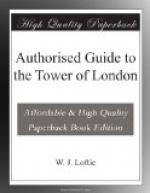At the end of the room is a Persian horse armour of brass scales connected by chain mail. Near this is the quilted armour of the Burmese General Maha Bundoola, killed in 1824. At the other end of the room is a large bell from Burmah, presented by the late General Sir William Gomme, G.C.B., and near it are two figures with Japanese armour, one of them presented to Charles II when prince by the Mogul. It is interesting as being one of the earliest examples of Eastern armour which has an authentic record of its presence in this country, and it also exhibits the persistence in early forms so common in the East. The cases on either hand contain weapons, helmets, and armour from most parts of our Indian Empire, as well as weapons from Cabul, Persia, Africa, America, and the South Seas. Some of these were presented by the Honourable East India Company, some were acquired by purchase after the Great Exhibition of 1851, and others have been added at various times. In the centre of the room are models showing the Tower buildings in the years 1842 and 1866.
The Large Room is now entered, and on the left is a case containing firearms, hand grenades, and a series of the rifled arms in use in the British Army since 1801. These include the two Baker rifles of 1801 and 1807; the Brunswick rifle, 1836; the Minie rifle, 1851; the Enfield rifle musket, 1855; the Snider, 1865; the Martini-Henry, 1871; and the Lee-Metford magazine rifle. On the right, between two grotesque figures, called Gin and Beer, from the entrance to the Buttery of the old Palace of Greenwich, is a case containing executioners’ swords (foreign), thumb-screws, the Scavenger’s Daughter for confining the neck, hands, and feet, bilboes for ship use, and thumb-screws. Observe also the so-called “Collar taken from the Spanish Armada,” which however was here in 1547, and has been in later times filled with lead to make it more terrible. It was only a collar for detention of ordinary prisoners. A conjectural model of the rack is also shown, but the only pictorial authority for this instrument (at no time a legal punishment) is a woodcut in Foxe’s Martyrs, the illustrations for which were drawn from German sources.
On the left hand are cases of European firearms of the first half of the present century, and two cannon made for the Duke of Gloucester, the son of Queen Anne. In the S.E. corner, on a platform, are several early cannon, including one, and part of another, from the wreck of the Mary Rose, sunk in action with the French off Spithead in 1545. These display the early mode of construction of such weapons, namely; bars of iron longitudinally welded together and encircled by hoops of the same metal. On the window side in the recesses are wall pieces, which belonged to the Honourable East India Company. The figure of Queen Elizabeth is supposed to represent her as on her way to St. Paul’s Cathedral after the destruction of the Spanish Armada. Near the lift are partizans carried by the Yeomen of the Guard, and round the pillars are the sergeants’ halberds used in the Army till about 1830. Observe the kettledrums captured at the battle of Blenheim, 1704.




